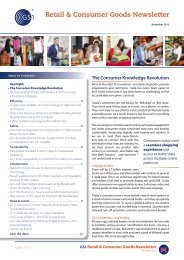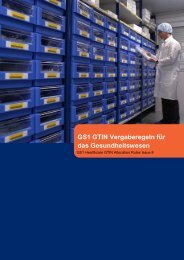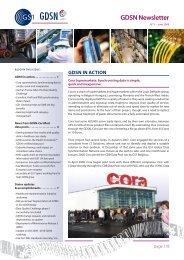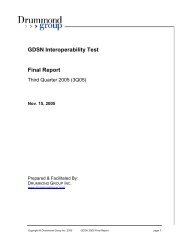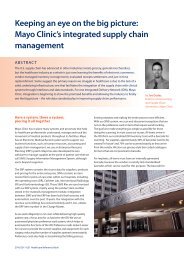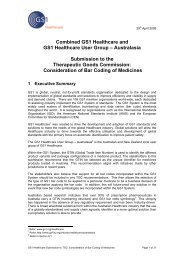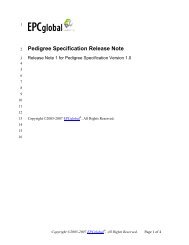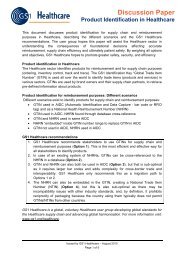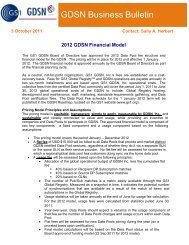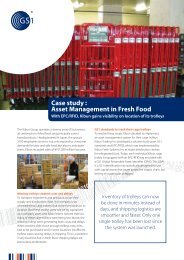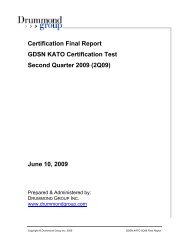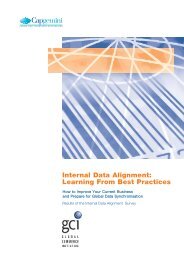The Application Level Events (ALE) Specification, Version 1.0 - GS1
The Application Level Events (ALE) Specification, Version 1.0 - GS1
The Application Level Events (ALE) Specification, Version 1.0 - GS1
You also want an ePaper? Increase the reach of your titles
YUMPU automatically turns print PDFs into web optimized ePapers that Google loves.
2633<br />
2634<br />
2635<br />
2636<br />
2637<br />
2638<br />
2639<br />
2640<br />
2641<br />
2642<br />
2643<br />
2644<br />
2645<br />
2646<br />
2647<br />
2648<br />
2649<br />
2650<br />
2651<br />
2652<br />
2653<br />
2654<br />
2655<br />
2656<br />
2657<br />
2658<br />
2659<br />
checkout clerk brought into the store that inadvertently happen to be read), something<br />
in the architecture needs to make sure such Items are not read or filter them out.<br />
Prevention might be achievable with proper portal design and the ability for the<br />
checkout clerk to override errant reads. Alternatively, the <strong>ALE</strong> implementation could<br />
filter errant reads via access to a list of Items (down to the serial number) that are<br />
qualified for sale in that store (this could be hundreds of thousands to millions of<br />
items), or the POS application itself could do it. With the list options, the requesting<br />
application would be responsible for maintaining the list.<br />
4. For retail front door theft detection, applications will request the full EPC of any<br />
Item that passes through the security point portal and that has not be marked as sold<br />
by the store and perhaps that meet certain theft detection criteria established by the<br />
store, such as item value. Like the retail checkout use case, the assumption is that the<br />
<strong>ALE</strong> implementation will have access to a list of store Items (to the serial number<br />
level) that have not been sold and that meet the stores theft alert conditions. <strong>The</strong><br />
requesting application will be responsible for maintaining the list, and will decide<br />
what action, if any, should be taken based on variables such as the value and quantity<br />
of Items reported.<br />
5. For retail shelf theft detection, applications will request the number of Items that<br />
were removed from the shelf since the last read cycle, totaled by Item GTIN across all<br />
serial numbers. Object types other than Item should be filtered out.<br />
6. For warehouse management, a relatively complex range of operations and thus<br />
requirements will exist. For illustration at this stage, one of the requirements is that<br />
the application will request the EPC of the slot location into which a forklift operator<br />
has placed a Pallet of products. Object types other than “slot” should be filtered out<br />
of the reading.<br />
<strong>The</strong> table below summarizes the <strong>ALE</strong> API settings used in each of these use cases.<br />
Use Case<br />
Event Cycle<br />
Boundaries<br />
1 (ship/rcpt) Triggered by<br />
pallet entering<br />
and leaving<br />
portal<br />
Result<br />
Set R<br />
2a (retail OOS) Periodic Additions<br />
&<br />
Deletions<br />
Report Settings<br />
Filter F(R)<br />
Complete Pallet &<br />
Case<br />
Item<br />
Report Type<br />
Group cardinality,<br />
G = pallet/case GTIN<br />
Group cardinality,<br />
G = item GTIN<br />
2b (retail OOS) Periodic Complete Item Group cardinality,<br />
G = item GTIN<br />
3 (retail ckout) Single Complete Item Membership (EPC)<br />
Copyright © 2005, 2004 EPCglobal Inc, All Rights Reserved. Page 62 of 71



